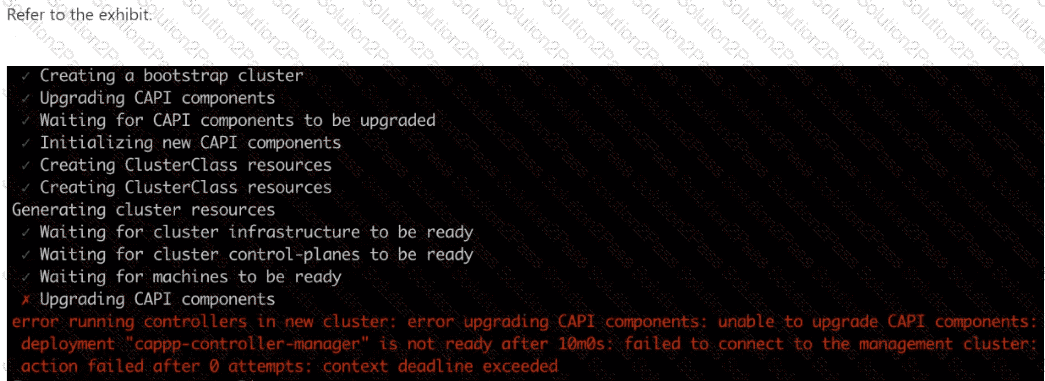NCP-CN Nutanix Certified Professional - Cloud Native (NCP-CN-6.10) Free Practice Exam Questions (2025 Updated)
Prepare effectively for your Nutanix NCP-CN Nutanix Certified Professional - Cloud Native (NCP-CN-6.10) certification with our extensive collection of free, high-quality practice questions. Each question is designed to mirror the actual exam format and objectives, complete with comprehensive answers and detailed explanations. Our materials are regularly updated for 2025, ensuring you have the most current resources to build confidence and succeed on your first attempt.
When deploying NKP using the Nutanix provisioning method (CAPX), what are the supported OS platforms?
A Platform Engineer needs to utilize the Konvoy Image Builder for building a custom operating system image. This image will be used to deploy clusters on various platforms. The engineer has been tasked with creating an OS image compatible with Konvoy’s requirements. In order to successfully build a compatible image using the Konvoy Image Builder, the engineer needs to ensure that a development environment meets the necessary prerequisites.
Which system is required to create a compatible OS image with the Konvoy Image Builder?
NKP cluster nodes require a disk for some of its deployed components, outside of an application’s persistent volume requirements. What are these components and where are they deployed?
Which CAPI provisioning method requires creating an inventory file of the servers to become NKP nodes?
Which two statements are true regarding deploying NKP on an Azure Kubernetes Service (AKS) Infrastructure? (Choose two.)
A Platform Engineer is running a Kubernetes cluster version 1.28.1 on AWS that needs to be upgraded to version 1.29.9. This cluster was deployed with Nutanix NKP. Which two actions should the engineer take to complete this requirement? (Choose two.)
A Cloud Engineer is deploying an NKP management cluster and plans to deploy multiple NKP workload clusters from it. The management cluster will be on Nutanix infrastructure, but the NKP workload clusters may be deployed in multiple provisioning environments, such as:
Nutanix
AWS
AzureWhen the engineer deploys an NKP workload cluster in AWS, which two default behaviors will be performed by NKP on this newly-deployed cluster? (Choose two.)
Prior to implementing NKP, a company had created a number of Kubernetes (K8s) clusters using kubeadm. While they are deploying new managed clusters via NKP, the company does not wish to migrate workloads from these pre-existing native K8s clusters over to new NKP clusters just yet.
What are the requirements to have these clusters attached to their NKP management cluster?
A Platform Engineer is getting started with NKP and has created a bastion host with all needed prerequisites.
How should the engineer install Kommander?
A Platform Engineer is deploying an NKP cluster within an air-gapped AWS environment. However, after an infrastructure planning session with the network team, it’s been determined that the default CIDR block range that is used by pods on NKP clusters is already in use in their environment.
How can the engineer ensure there are no collisions between NKP pod traffic and the existing network using that subnet range?

An administrator is provisioning an NKP cluster. After the VM creation task, the error shown in the exhibit is produced.
What could be the reason?
An administrator has experienced issues with an NKP-managed workload cluster and has been tasked with deploying NKP Insights in order to:
Resolve common anomalies
Check security issues
Verify whether workloads follow best practicesUpon trying to enable NKP Insights, the cluster that needs to be chosen is grayed out.Which missing prerequisite should be enabled?
A Platform Engineer is going to deploy NKP to a Nutanix cluster on-prem as well as Amazon EKS. What is the function of the bootstrap cluster for this architecture?
A Platform Engineer has been tasked with backing up and restoring a production environment to ensure persistent data is available during a disaster at a primary site. What is recommended for backup and restore production use cases?
A company is required by NIST to follow FIPS guidelines for compliance.
What is the first step for enabling FIPS in NKP?
An administrator has been tasked with deploying NKP as the Kubernetes platform and needs to deploy their first cluster with the following requirements:
Dark site (no Internet connectivity)
Nutanix-provided Rocky Linux VM image
AHV-based clusterWhat are two prerequisites to accomplish the deployment? (Choose two)
A development team is working on a new application that requires access to certain cluster resources. The team needs to ensure that they have limited permissions to avoid unauthorized changes in other environments. Among the tasks they will perform are the following:
Deploy new versions of the application to their specific namespace.
Scale deployments according to demand.
View logs and metrics of their applications to monitor performance.When using the NKP GUI, what type of access should the team configure?

A current Nutanix cluster is hosting an NKP cluster and a production Kubernetes cluster named production. Infrastructure administrators recently added three nodes with NVidia GPUs for a new AI initiative, and now a Platform Engineer has been asked to add three workers with the GPUs to the production Kubernetes cluster. Which first step should the engineer take to achieve this task?
A Platform Engineer is attempting to delete an attached cluster from the NKP UI, but it is stuck in a 'deleting' state and does not get removed. How can the engineer resolve this attempt to detach the cluster so that it is removed from the UI and no longer managed by NKP?
A company has enabled auto-scaling within an NKP cluster. What is the behavior for auto-scaling?
